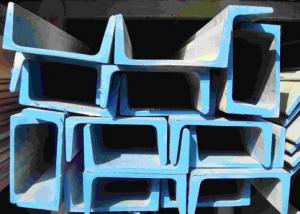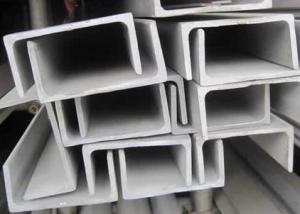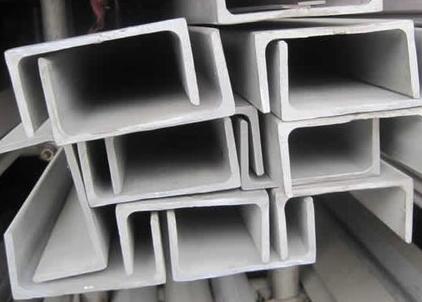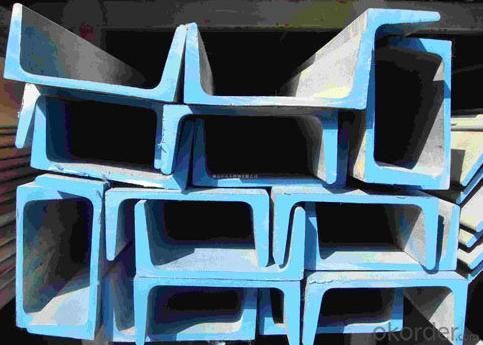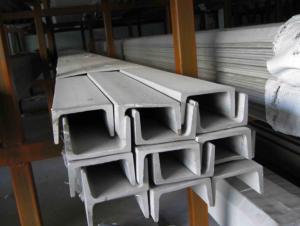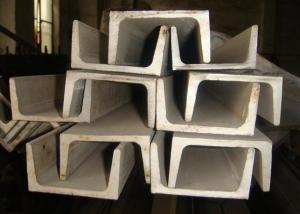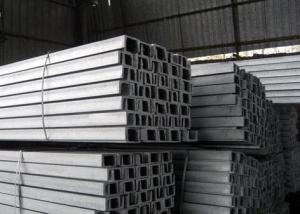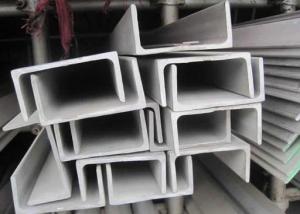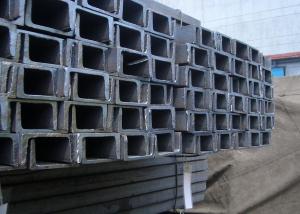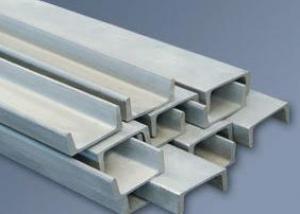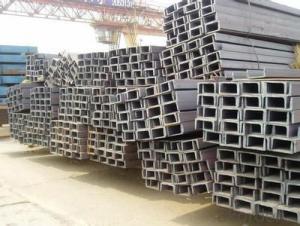201 Stainless Steel Channels
- Loading Port:
- China Main Port
- Payment Terms:
- TT or LC
- Min Order Qty:
- 5 Tons m.t.
- Supply Capability:
- 1000 Tons Per Month m.t./month
OKorder Service Pledge
OKorder Financial Service
You Might Also Like
Stainless Steel Channel
1.Size: 3mm to 24mm Thickness
2.Material:SUS201,202,301,304,304L,316,316L ,321 etc.
3.Length: 4m to 6m,or according to the customer's requirement
4.Standard: AISI,JIS,GB,DIN
5.Finish: Cold Drawn ,hot rolled & Polishing
6.Testing: Each heat number and batch must be tested for both chemical and mechanical properties
7.Application: Produce screw and nut, engine parts, indoor and outdoor decorating,etc.
|
Size (mm) |
Thickness (mm) | ||||||||
|
H×B |
3 |
4 |
5 |
6 |
7 |
8 |
9 |
10 |
12 |
|
Mass (Kg/m) | |||||||||
|
40×20 |
1.79 |
|
|
|
|
|
|
|
|
|
50×25 |
2.27 |
|
|
|
|
|
|
|
|
|
60×30 |
2.74 |
3.56 |
4.37 |
5.12 |
|
|
|
|
|
|
70×35 |
3.23 |
4.21 |
5.17 |
6.08 |
|
|
|
|
|
|
80×40 |
3.71 |
4.84 |
5.96 |
7.03 |
|
|
|
|
|
|
90×45 |
4.25 |
5.55 |
6.83 |
8.05 |
|
|
|
|
|
|
100×50 |
4.73 |
6.18 |
7.62 |
8.98 |
10.3 |
11.7 |
13 |
41.2 |
|
|
120×60 |
|
|
9.2 |
10.9 |
12.6 |
14.2 |
|
|
|
|
130×65 |
|
|
10.1 |
11.9 |
13.8 |
15.5 |
17.3 |
19.1 |
|
|
140×70 |
|
|
|
12.9 |
14.9 |
16.8 |
18.8 |
20.7 |
|
|
150×75 |
|
|
|
13.9 |
16 |
18.1 |
20.2 |
22.2 |
26.3 |
|
160×80 |
|
|
|
14.8 |
17.1 |
19.3 |
21.6 |
23.8 |
28.1 |
|
180×90 |
|
|
|
16.7 |
19.4 |
22 |
24.5 |
27 |
32 |
|
200×100 |
|
|
|
18.6 |
21.6 |
24.5 |
27.4 |
30.2 |
35.8 |
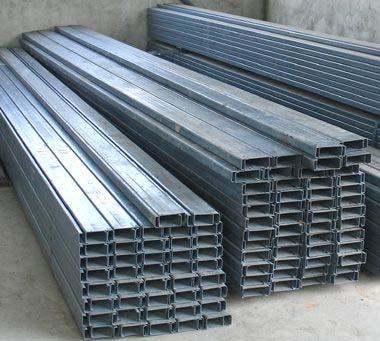
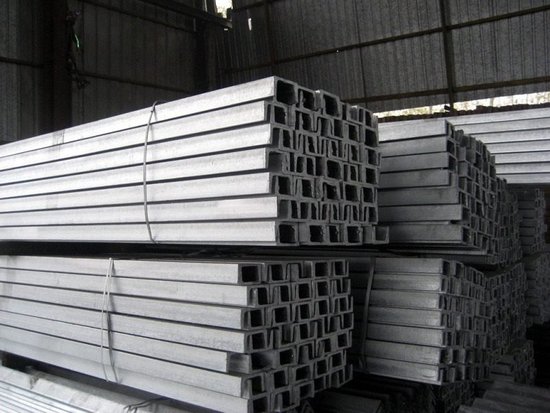
- Q: Are stainless steel channels fire-resistant?
- Yes, stainless steel channels are considered fire-resistant. Stainless steel is a material that has excellent fire resistance properties due to its high melting point and low thermal conductivity. It has the ability to retain its structural integrity even at extremely high temperatures. This makes stainless steel channels a reliable choice for applications where fire resistance is a critical factor, such as in the construction of fire-rated walls, ceilings, and other fire containment systems. Additionally, stainless steel does not release toxic gases or emit smoke when exposed to fire, further enhancing its fire-resistant properties.
- Q: What are the vibration damping properties of stainless steel channels?
- Stainless steel channels, due to their material composition and structural design, possess excellent vibration damping properties. The unique properties of stainless steel, such as its high density, stiffness, and low internal damping, enable it to effectively absorb and dissipate vibrations. The dense nature of stainless steel channels allows them to minimize the transmission of vibrations, reducing their intensity and impact on surrounding structures or equipment. This makes stainless steel channels ideal for applications where vibration control is crucial, such as in architectural structures, machinery, or transportation systems. Additionally, stainless steel's high stiffness helps to dampen vibrations by resisting deformation under dynamic loads. This stiffness prevents excessive movement and oscillation, thereby reducing vibration-induced noise and potential damage. Furthermore, stainless steel exhibits low internal damping, which means it has the ability to dissipate and absorb energy efficiently. This property ensures that vibrations are effectively attenuated within the material itself, minimizing the propagation of vibrations to other connected components or structures. Overall, the vibration damping properties of stainless steel channels make them a reliable choice for various applications that require vibration control, ensuring enhanced performance, stability, and longevity of structures and equipment.
- Q: Can stainless steel channels be used for stair stringers?
- Indeed, stair stringers can utilize stainless steel channels. Due to its durability and resistance to corrosion, stainless steel proves to be a prime option in outdoor or high-moisture settings. Offering exceptional structural support and the ability to bear substantial loads, stainless steel channels are well-suited for stair stringer applications. Moreover, stainless steel possesses a sleek and contemporary look that can elevate the overall visual appeal of a staircase. Nevertheless, it is crucial to verify that the stainless steel channels adhere to the required building codes and regulations for stair construction.
- Q: Can stainless steel channels be used for industrial shelving?
- Yes, stainless steel channels can be used for industrial shelving. Stainless steel is known for its durability, strength, and resistance to corrosion, making it suitable for use in industrial environments. Stainless steel channels offer sturdy support and can withstand heavy loads, making them an ideal choice for industrial shelving applications.
- Q: 440C stainless steel heat treatment how to do ah?
- For automatic lathes, martensitic stainless steels, like ordinary alloy steels, have the properties of hardening by hardening, so that a wide range of mechanical properties can be obtained by selecting grades and heat treatment conditions.
- Q: Are stainless steel channels suitable for use in the mining industry?
- Yes, stainless steel channels are suitable for use in the mining industry. Stainless steel is known for its excellent corrosion resistance, which makes it ideal for applications in harsh environments such as mines. The mining industry often involves exposure to water, chemicals, and abrasive materials, all of which can cause corrosion and deterioration in other types of materials. However, stainless steel is highly resistant to corrosion, ensuring longevity and durability in mining applications. Stainless steel channels also have high strength and impact resistance, making them capable of withstanding heavy loads and harsh conditions commonly found in the mining industry. This strength is crucial for supporting structures, equipment, and machinery in mining operations. Additionally, stainless steel channels have excellent heat resistance, allowing them to maintain their structural integrity even in high-temperature mining environments. Furthermore, stainless steel channels offer versatility in design and construction. They can be easily customized and fabricated to meet specific requirements, allowing for efficient and effective installation in various mining applications. Stainless steel is also easy to clean and maintain, reducing downtime and increasing productivity in mining operations. In summary, stainless steel channels are a suitable choice for the mining industry due to their corrosion resistance, strength, impact resistance, heat resistance, versatility, and ease of maintenance. Whether used in structural support, equipment fabrication, or other applications, stainless steel channels provide the durability and reliability needed for the demanding conditions of the mining industry.
- Q: What are the different surface patterns or textures available for stainless steel channels?
- Some of the different surface patterns or textures available for stainless steel channels include brushed, polished, matte, embossed, and hammered finishes.
- Q: What is the lifespan of stainless steel channels?
- The lifespan of stainless steel channels can vary depending on different factors, including the grade of stainless steel used, environmental conditions, maintenance practices, and the intended application. Stainless steel is widely recognized for its exceptional corrosion resistance, which greatly enhances its longevity compared to other metals. With proper care and maintenance, stainless steel channels can typically endure for multiple decades or even longer. The higher the grade of stainless steel, the greater its resistance to corrosion and overall durability, resulting in an extended lifespan. Grade options like 304 and 316 are frequently chosen for stainless steel channels due to their superior ability to resist rust and corrosion. Nevertheless, it is important to acknowledge that stainless steel channels may still be vulnerable to specific forms of corrosion, such as pitting or crevice corrosion, particularly in harsh environments or when exposed to certain chemicals. Regular maintenance and appropriate cleaning can effectively prevent or mitigate these issues, thereby further prolonging the lifespan of stainless steel channels. Ultimately, it is advisable to consult stainless steel manufacturers, engineers, or industry experts to accurately determine the anticipated lifespan of stainless steel channels based on the specific application and conditions they will encounter.
- Q: Can stainless steel channels be used in the construction of overhead crane systems?
- Yes, stainless steel channels can be used in the construction of overhead crane systems. Stainless steel channels offer excellent strength, durability, and corrosion resistance, making them suitable for demanding industrial applications like overhead crane systems.
- Q: What are the different surface treatment options available for stainless steel channels?
- There are several surface treatment options available for stainless steel channels, each offering unique benefits and enhancing the overall appearance and performance of the material. Some of the commonly used surface treatments for stainless steel channels include: 1. Polishing: This treatment involves using abrasive materials to remove any imperfections or roughness on the surface of the stainless steel channels. It results in a smooth and shiny finish, enhancing the aesthetics of the material. 2. Passivation: Passivation is a chemical treatment that removes surface contaminants and forms a thin protective layer on the stainless steel channels. This treatment helps prevent corrosion and improves the material's resistance to staining and discoloration. 3. Electropolishing: This treatment involves immersing the stainless steel channels in an electrolyte solution and applying an electric current to remove surface metal. It results in a smooth, shiny, and clean surface, further improving the material's corrosion resistance. 4. Powder Coating: Powder coating is a technique where a dry powder is electrostatically applied to the surface of the stainless steel channels. The channels are then heated, causing the powder to melt and form a protective layer. Powder coating offers excellent durability and resistance to abrasion, chemicals, and UV radiation. 5. PVD Coating: Physical Vapor Deposition (PVD) is a process where a thin layer of metal is deposited onto the stainless steel channels using a vacuum chamber. This treatment offers various color options, enhances the material's wear resistance, and provides a decorative finish. 6. Brushed Finish: Brushing involves using abrasive materials to create a textured or matte finish on the surface of the stainless steel channels. This treatment masks any imperfections and gives the material a unique and distinctive appearance. 7. Bead Blasting: Bead blasting involves propelling small abrasive particles against the surface of the stainless steel channels at high velocity. This treatment creates a uniform and matte finish, ideal for applications where a non-reflective surface is desired. Each of these surface treatment options for stainless steel channels offers specific advantages depending on the desired outcome, such as improved aesthetics, corrosion resistance, durability, or enhanced performance in specific environments. It is essential to consider the specific application requirements and consult with professionals to determine the most suitable surface treatment option for stainless steel channels.
1. Manufacturer Overview
| Location | Jiangsu, China |
| Year Established | 2010 |
| Annual Output Value | above US$8 million |
| Main Markets | East Asia, Middle East, West Europe |
| Company Certifications |
2. Manufacturer Certificates
| a) Certification Name | |
| Range | |
| Reference | |
| Validity Period |
3. Manufacturer Capability
| a) Trade Capacity | |
| Nearest Port | Shanghai |
| Export Percentage | |
| No.of Employees in Trade Department | above 50 people |
| Language Spoken: | English, Chinese, Arabic |
| b) Factory Information | |
| Factory Size: | about 15000 square meter |
| No. of Production Lines | above 4 |
| Contract Manufacturing | OEM Service Offered,Design Service Offered |
| Product Price Range | Average |
Send your message to us
201 Stainless Steel Channels
- Loading Port:
- China Main Port
- Payment Terms:
- TT or LC
- Min Order Qty:
- 5 Tons m.t.
- Supply Capability:
- 1000 Tons Per Month m.t./month
OKorder Service Pledge
OKorder Financial Service
Similar products
Hot products
Hot Searches
Related keywords
